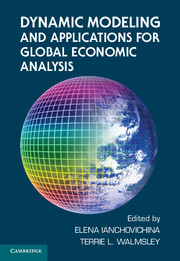Book contents
- Frontmatter
- Contents
- Contributors
- Acknowledgments
- PART I INTRODUCTION AND OVERVIEW
- PART II STRUCTURE OF THE DYNAMIC GTAP FRAMEWORK
- PART III APPLICATIONS OF DYNAMIC GTAP
- 8 Assessing the Impact of China's WTO Accession on Investment
- 9 Dynamic Effects of the “New-Age” Free Trade Agreement between Japan and Singapore
- 10 Resource Use and Technological Progress in Agriculture
- 11 Global Economic Integration and Land-Use Change
- 12 The Contribution of Productivity Linkages to the General Equilibrium Analysis of Free Trade Agreements
- 13 Global Demographic Change, Labor Force Growth, and Economic Performance
- PART IV EVALUATION OF THE DYNAMIC GTAP FRAMEWORK
- Appendix: Negative Investment: Incorporating a Complementarity into the Dynamic GTAP Model
- Glossary of GDyn Notation
- Index
- References
11 - Global Economic Integration and Land-Use Change
Published online by Cambridge University Press: 05 June 2012
- Frontmatter
- Contents
- Contributors
- Acknowledgments
- PART I INTRODUCTION AND OVERVIEW
- PART II STRUCTURE OF THE DYNAMIC GTAP FRAMEWORK
- PART III APPLICATIONS OF DYNAMIC GTAP
- 8 Assessing the Impact of China's WTO Accession on Investment
- 9 Dynamic Effects of the “New-Age” Free Trade Agreement between Japan and Singapore
- 10 Resource Use and Technological Progress in Agriculture
- 11 Global Economic Integration and Land-Use Change
- 12 The Contribution of Productivity Linkages to the General Equilibrium Analysis of Free Trade Agreements
- 13 Global Demographic Change, Labor Force Growth, and Economic Performance
- PART IV EVALUATION OF THE DYNAMIC GTAP FRAMEWORK
- Appendix: Negative Investment: Incorporating a Complementarity into the Dynamic GTAP Model
- Glossary of GDyn Notation
- Index
- References
Summary
Introduction and Motivation
Land-use change – in particular deforestation – has contributed substantially to current greenhouse gas concentrations in the atmosphere. In addition, agriculture and forestry have a potentially very significant role to play in stabilizing greenhouse gas concentrations. According to results from the EMF-21 (Energy Modeling Forum) study models, land-based mitigation strategies are a significant part of the mitigation portfolio required for a climate stabilization policy, accounting for anywhere from 18 to 72% of total abatement by 2050 and 15 to 44% of total abatement by 2100 (Rose et al. 2007). The efficiency of any strategy, however, depends critically on the baseline land-use changes. In turn, those changes depend on many factors, the most important of which are population and per capita income growth, as well as the degree of integration in the global economy.
In this chapter, we modify and extend the GDyn model to investigate the role of population and per capita income growth and of global economic integration in determining long-run patterns of land-use change, where that change is decomposed by agro-ecological zone (AEZ).We are able to isolate the impact of each of these three factors on the development of land use in the long-run through a series of carefully designed simulations. Although the impact of population and income growth on the derived demand for land is relatively predictable, once supply-side constraints are brought to bear, the picture becomes more complex.
- Type
- Chapter
- Information
- Dynamic Modeling and Applications for Global Economic Analysis , pp. 290 - 311Publisher: Cambridge University PressPrint publication year: 2012



